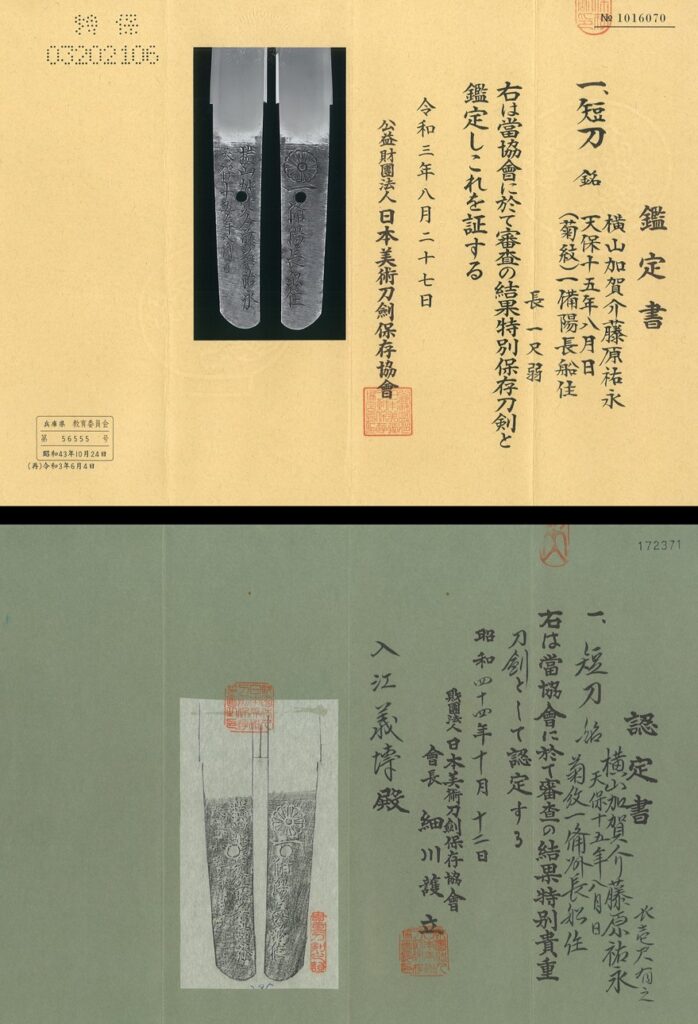一般情報 General information
|
製品番号 Product No. |
Tanto-002. |
|
剣の種類 Sword type |
短刀 Tanto. |
|
銘 MEI (表 Omote) |
横山加賀介藤原祐永 Yokoyama Kaga no Suke Fujiwara Sukenaga 天保十五年八月日 Tenpō jû go nen hachi gatsu hi |
|
銘 MEI (裏 Ura) |
(菊紋) 一横陽長船住 (Kiku Mon) Ichi Biyo Osafune ju |
|
時代 Era |
天保 Tenpō, 1830-1844 |
|
日付 Date |
天保十五年八月日 Tenpō Jû Go Nen Hachi Gatsu Hi, One day in August, 1844 |
|
州 Province |
備前 Bizen |
|
伝 School |
横浜 伝 Yokohama school |
|
父 Father |
祐平 Sukehira |
|
|
|
|
|
|
寸法 Measurements
|
長さ Nagasa |
30.1 cm |
|
反り Sori |
0.3 cm |
|
元幅 Motohaba |
2.81 cm |
|
先幅 Sakihaba |
2.40 cm |
|
重ね Kasane |
0.55 cm |
|
中子 Nakago |
10.9 cm |
|
重さ Weight |
240 Gr. |
|
|
|
|
|
鑑定書 Kantei-sho
|
日本美術刀剣保存協会 NBTHK Certificate |
特別保存刀剣 Tokubetsu Hozon tōken 特別貴重刀剣 Tokubetsu Kicho tōken |
|
他の証明書 Other certificate |
適用外です Not applicable |
|
考課 Appraisal 鑑定 Kantei |
上作 Jyo Saku Superior |
|
状態 Status |
優秀な Excellent |
|
研磨 Polish |
平均研磨上記 above average polishing |
|
切れ味の分類 Classification on sharpness |
業物 Wazamono |
|
|
|
|
|
|
詳細 Details
|
姿 Sugata |
平造 Hira-zukuri, 庵棟 Ihori-mune |
|
肌 Hada |
小板目 Ko-Itame |
|
切先 Kissaki |
横手鋒 Yokote Nonai Kissaki |
|
刃文 Hamon |
丁子乱れ Choji-midare |
|
彫物 Horimone |
n/a |
|
帽子 Bōshi |
乱れ込 Midare-Komi, 小丸 Ko-Maru |
|
中心 Nakago |
生中子 Ubu nakago, 切りKiri file pattern, 茎尻 nakago jiri |
|
目釘穴 Mekugi-ana |
一個, One (1) mekugi ana. |
|
はばき Habaki |
銀着 二重鎺はばき Double foiled silver Habaki |
|
|
|
|
|
|
|
外装 Koshirae |
外装 Koshirae: 合口拵 Aikuchi style koshirae. 鉄刀装具銀象嵌 Iron tosogu set with silver inlay 伝 Den/School: 奈良 Nara? 国 Country: 江戸 Edo. 時代 Era: 中江戸時代 Middle Edo period. 日付 Date: ca.1725-1750. 刀装具 Tosogu: 小柄 Kozuka: 設計 Design: 枝に梅花 Plum blossoms on a branch 時代 Era: 中江戸時代 Middle Edo period. 日付 Date: ca.1725-1750. 小刀 Kogatana: 銘 MEI: 丹波守吉道 Tanba-no-kami Yoshimichi. (2nd gen. or later). 時代 Era: 中江戸時代 Middle Edo period. 日付 Date: ca.1725-1750.
物質 Material: 赤銅 shaku-dô plate, 須賀銅 Suaka copper base, engraved with 真鍮brass, yellow & red 銅 copper 金箔 gold leaf/ 金 gold colored. 技法 Technique: 高彫象嵌 Takabori zogan.
|
|
|
|
|
自鞘 Shira-saya |
The blade is polished and stored in a nice Shirasaya with a purple-coloured silk bag. |
|
|
|
|
|
|
|
鞘書 Sayagaki |
適用外です Not applicable |
|
|
|
|
|
|
|
追加情報 Additional Information |
1th The judgment on the authentic as expressed in the description above was confirmed by “Nippon Bijutsu Tōken Hozon Kyokai” (NBTHK) issuing a 特別保存刀剣 Tokubetsu hozon tōken certificate: number 1016070. Provided on 令和三年八月二十七日Reiwa jû nen hachi gatsu ni jû hachi hi, August 27, 2021 (27-08-2021). 2nd The judgment on the authentic as expressed in the description above was confirmed by “Nippon Bijutsu Tōken Hozon Kyokai” (NBTHK) issuing a 特別貴重刀剣 Tokubetsu Kicho tōken certificate: number 172371. Provided on 昭和四十四年十月十二日 Shōwa shi jû shin nen jû gatsu jû ni hi, October 12, 1969 (12-10-1969). 祐永 Sukenaga is a 別席 Betseki, special class sword-smith. |
|
|
|
|
|
|
|
歴史 History |
„Bishū Osafune Sukenaga“ (備州長船祐永), he was the second son of Sukehira (祐平) and his successor because the first-born son Sukemori (祐盛) was adopted by the 11th gen. Shichibei Sukesada (七兵衛祐定), Sukenaga was the best smith of the shinshintō-era Bizen-Yokoyama group and we know blades from the early Tenpō era (天保, 1830-1844) to the third year of Kaei (嘉永, 1850), he died on the second day of the sixth month Kaei four (嘉永, 1851) at the age of 57, he signed also with a chrysanthemum and the character for „Ichi“ (一) and claimed to be the 56th gen. after Tomonari („Tomonari gojūroku-daison“, 友成五十六代孫), dense ko-itame which tends to muji, chōjimidare in nioi-deki, the chōji can also tend to kikka-chōji or kobushi-gata-chōji, narrow sugu-yakidashi, we also know hamon in ko-nie-deki like gunome-chōji or suguha (Info from Markus) 新刀期の横山一派は備前国長船の地で栄え、新々刀期を経て明治の廃刀令まで続く御家です。横山加賀介藤原朝臣祐永は「友成五十六代孫」と号しました。本作は祐永の円熟した技が随所に見られる作品です。 本刀体配は、刃長が一尺弱。平造で、身幅、重ね共に確りとし、姿が美しい短刀です。地鉄は小板目肌がよく練れて地沸が付き淡く映りが立ちます。刃文は匂い口締まりこころに小沸がついて、直で焼き出し丁子乱になる明るく冴えた刃文を焼いています。刃中には足、葉が働きます。帽子はそのまま乱れて先小丸へ深く返ります。茎は生ぶで錆味がよく、確りとした鏨使いで菊紋と一文字、さらに長銘が刻されています。この作品は焼刃の完成度の高さ、要するに匂いの強さと幅が限りなく均一に焼かれている点、それらを実現するためには鍛肌が密でなければならず、本刀は何時もながらに上手であり、横山祐永の作域の特徴が顕著に表れ、卓越した技量を十分に示した感動の逸品です。銀無垢二重はばき、特別保存刀剣鑑定書。 The Yokoyama clan in the Shintou period flourished in the land of Osafune in Bizen Province, and continued through the Shinshintou period until the Meiji era ban on swords. Yokoyama Kagasuke Fujiwara no Ason Sukenaga called himself ‘Tomonari fifty-sixth grandson’. This work is a work in which Yuunaga’s mature technique can be seen everywhere. The blade length of the main sword arrangement is a little less than 1 shaku. It is a flat sword with a solid width and stacking, and a beautiful figure. The ground iron has a well-kneaded koitame-hada, which gives it a faint reflection. The blade pattern is a bright and clear blade pattern that has a tight mouth and a small boil in the heart, and is directly baked. The legs and leaves work in the blade. The hat is disturbed as it is and returns deeply to the Sakikomaru. The stem is fresh and has a good rust taste, and the chrysanthemum crest, one character, and a long signature are engraved with a solid chisel. This work has a high degree of perfection of the baked blade, in other words, the strength and width of the smell are uniformly baked. It is an impressive masterpiece that fully demonstrates the outstanding skill of Yokoyama Yukenaga. Solid silver double habaki, specially preserved sword appraisal certificate. |
価格 price € 9250,– (Shipping fee is not included in the price).
PS: More photos available on request!




